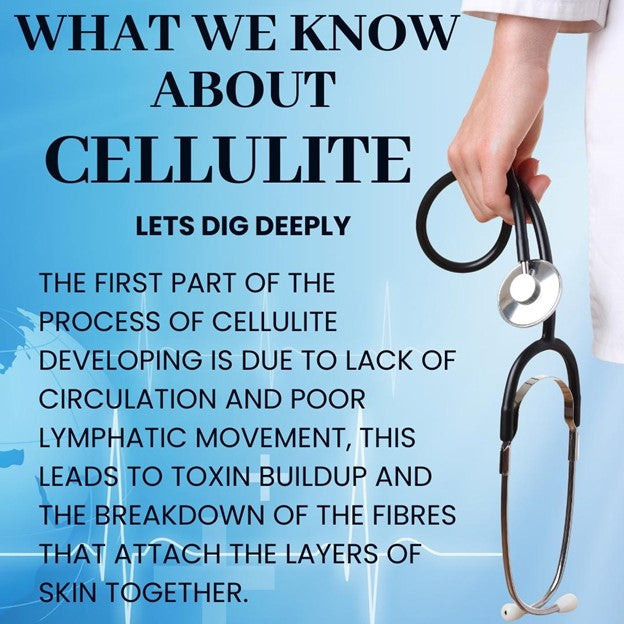The first part of the process of cellulite developing is due to lack of circulation and poor lymphatic movement, this leads to toxin buildup and the breakdown of the fibers that attach the layers of skin together.
Anatomy of cellulite
Cellulite is a very common, harmless skin condition that causes lumpy, dimpled flesh on the thighs, hips, buttocks and abdomen. The condition is most prevalent in women. Many people try, with variable success, to improve the appearance of their skin through weight loss, exercise, massage and creams marketed as a solution to cellulite. Medically proven treatment options are available as well, though results aren't immediate or long lasting.
Symptoms
Cellulite looks like dimpled or bumpy skin. It's sometimes described as having a cottage cheese or orange peel texture. You can see mild cellulite only if you pinch your skin in an area where you have cellulite, such as your thighs. Cellulite that is more severe makes the skin appear rumpled and bumpy with areas of peaks and valleys. Cellulite is most common around the thighs and buttocks, but it can also be found on the breasts, lower abdomen and upper arms.
Causes
Little is known about what causes cellulite. It involves fibrous connective cords that tether the skin to the underlying muscle, with the fat lying between. As fat cells accumulate, they push up against the skin, while the long, tough cords pull down. This creates an uneven surface or dimpling. In addition, hormonal factors play a large role in the development of cellulite, and genetics determine skin structure, skin texture and body type. Other factors, such as weight and muscle tone affect whether you have cellulite, though even very fit people can have it.
Risk factors
Cellulite is much more common in women than in men. In fact, most women develop some cellulite after puberty. This is because women's fat is typically distributed in the thighs, hips and buttocks — common areas for cellulite. Cellulite is also more common with aging, when the skin loses elasticity. Weight gain can make cellulite more noticeable, but some lean people have cellulite, as well. It tends to run in families, so genetics might play the biggest role in whether you develop cellulite. An inactive lifestyle also can increase your chances of having cellulite, as can pregnancy.
Treatments
Massage therapy: Different massage techniques, such as manual lymphatic drainage, deep tissue massage, or massage devices, are believed to stimulate circulation, promote lymphatic drainage, and reduce fluid retention. Regular massages can temporarily improve the texture and smoothness of the skin. Compression boots, also known as pneumatic compression devices, are typically used for medical purposes such as improving circulation and preventing blood clots. However, some people also use compression boots as part of their cellulite treatment regimen.
ref. to https://www.harpersbazaar.com/uk/beauty/skincare/news/a41426/cellulite-treatmentsexplained/#:~:text=The%20first%20part%20of%20the,the%20layers%20of%20skin%20together.
ref. to https://www.mayoclinic.org/diseases-conditions/cellulite/symptoms-causes/syc-20354945
